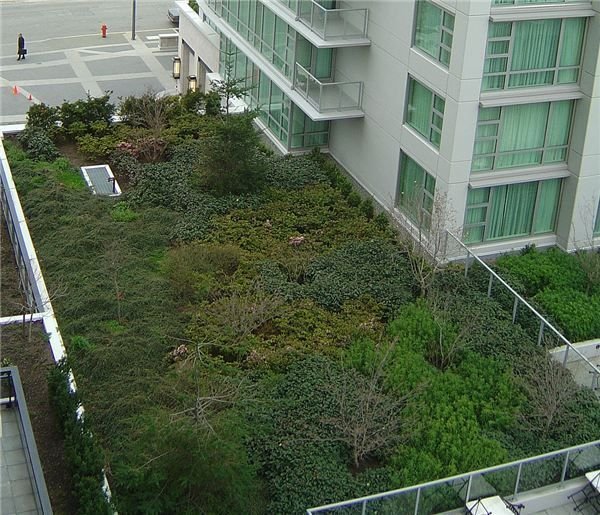- For over 70 years the concept of placing live ecosystems on top of buildings in the U.S. has been pursued as an environmentally friendly alternative to traditional roofing materials. These systems range from discreet box gardens covering minimal surface area to eave-to-eave plots covering the entire roof.The idea of planting a live roof actually originated in Europe long ago, mainly as a cheaper and more readily available alternative to more robust roofing systems at the time. And while the benefits and maintenance of these “living roofs” is the subject of much discussion, the successful construction of these systems requires attention to several factors: material specifications, structural loads, and water handling.
-
Greener Material Specifications
In order to sustain living plants, the planted roof must have soil. Just like any other planted area, the soil must contain nutrients and have proper aeration and water. The construction materials selected for such a system therefore must be able to resist exposure to soil chemistry and fertilizers, physical abrasion from tilling, and contact with insects, animals, roots and soil, and to the constant presence of moisture. In addition, failure of the selected roofing materials may require excavation which would be a considerable undertaking for full roof plantings.Most traditional roofing materials are not formulated for constant contact with soil chemistry, and are designed to shed moisture and spend at least part of their life cycle in a dry, well ventilated state. Membranes, insulation, drains, and containment supports should then be selected based on zero maintenance, below grade specifications such as those used beneath pavements, foundations, and patios as opposed to standard roofing criteria.Structural Loads - Weight of Green Rooftops
One cubic foot of dry, agricultural dirt or loam typically used for a “green” roof weighs between 75 and 81 pounds. Saturated with water the weight can increase by as much as 35%, to around 100 to 110 pounds per cubic foot. This means 100 square feet of planted roof containing soil 6 inches deep can add over 5000 pounds of dead load to the roof structure, roughly 50 p.s.f. or more.Four discrete planter boxes or containers 6 feet long, 2 feet wide with 1 foot depth of soil applies a similar load. Add a blocked water drain and the weight starts adding up at the rate of 5 p.s.f per inch of standing water. Add a conservative snow load allowance for flat roofs of 15 p.s.f., and the design criteria can easily exceed 70 p.s.f. dead load. For a modest building using 2500 sq.ft. of living roof construction this could translate to 175,000 pounds of dead load on the roof top. Constructed in a seismic zone this can become an unexpectedly live load directly above the heads of the building occupants.Finally, if the planting is intended to be a tended garden additional live loads will be incurred by equipment, gardeners, and visitors if applicable. Whether for new construction or for retrofitting existing roofs, structural engineering design is required for anything more than a few square feet of planted roof area.Watering and Drainage
Live plants not only need water to maintain growth, but need adequate drainage to prevent disease and rot. A living roof also requires excellent drainage to prevent a flood event, which could have disastrous consequences at rooftop level. Again, drains designed for below grade applications with constant soil contact and zero maintenance are required as opposed to conventional roof drainage systems. A layer of agricultural lightweight aggregate or pea gravel covered with a suitable filter fabric is usually adequate. There are also proprietary formed drain systems available, such as synthetic fiber mats and cellular matrices, which are thinner, lighter, and can increase drainage rates but usually at higher cost. Additionally the drainage design should incorporate several collection points serving a given area in case one drain becomes clogged. Finally, active irrigation needs to be closely monitored to avoid excess water weight as mentioned previously.LEEDing The Way
With these construction considerations in mind, a properly designed and executed living roof can be an excellent choice for building construction. Some estimates indicate more than 20 LEED points can be obtained from such a system, not to mention the purely aesthetic improvements that can be achieved.

hi Iam Jagadesh. Now I Really Felt on This Blog Because of Goog Articles daily posted to me.via mail
ReplyDeleteThanks For Ur Subscription With Us
DeleteReally Good Article by admin.....GREEN Energy is Neccessary For Civil engineers
ReplyDeleteThanks pls Support Us
DeleteWhat about LEED in GREEN Buildings
ReplyDeleteLEED is an Association Committe For GReen Buildings Design and Construction by Civil engineers...With these construction considerations in mind, a properly designed and executed living roof can be an excellent choice for building construction. Some estimates indicate more than 20 LEED points can be obtained from such a system, not to mention the purely aesthetic improvements that can be achieved.
Delete